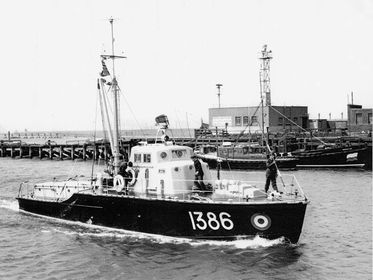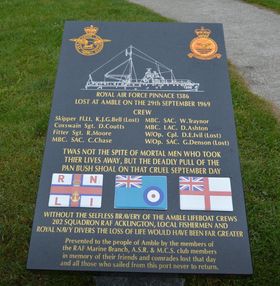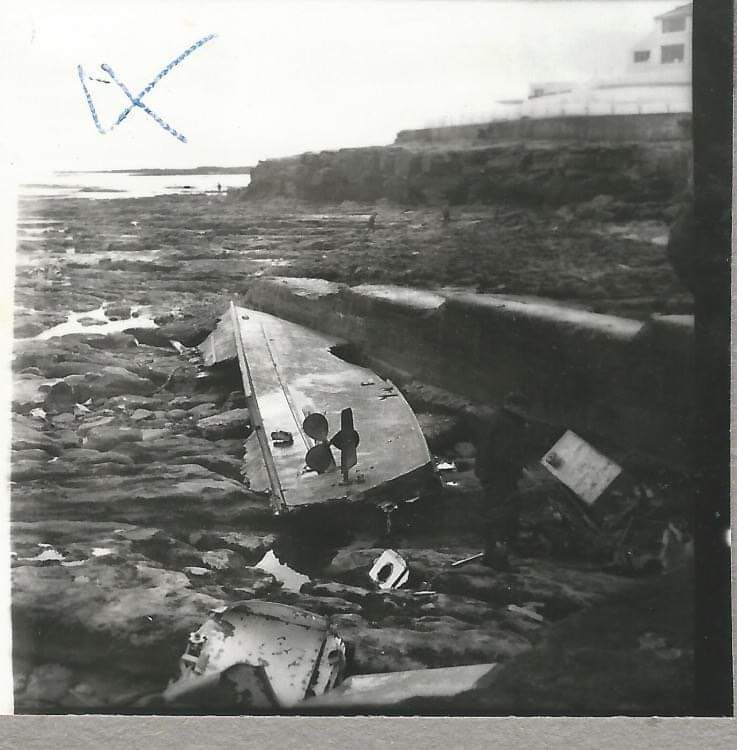Remembering a local tragedy: the loss of RAF Pinnace 1386
At this time I thought it would be nice to re post the report of the tragic loss of 1386 so splendidly displayed below, it’s a long read, but a story of great bravery as well as tragedy!

RAF Pinnace 1386
Bridlington disaster – September 1969 The loss of Pinnace 1386. The mk2 63ft pinnace were in my opinion and of many who served on them the most seaworthy of the launches we used, and the most stable. No pinnace had ever been lost due to weather or sea conditions.
1386 from the Marine Craft Unit at Bridlington had been working with helicopters from Leuchars, and was returning to base on passage from Dundee. Due to the sea conditions, the skipper decided to stop over at Amble Harbour. Whilst attempting to enter Amble harbour during bad weather and heavy seas 1386 capsized in 20-30 ft waves. Of the crew of eight, four were pulled from the sea by small craft.
The vessel was towed into shallow waters near the south pier by the Amble Lifeboat. Four men were trapped in the upturned hull, lifeboatmen smashed through the hull to rescue a deckhand who had been trapped for 6 hours. Three lives lost.

Newspaper cuttings of the tragedy
Two Bravery awards were granted for this incident, one to a member of the helicopter crew, and one to a crewmember of the launch, both citations were published in the Supplement to the London Gazette of the 22nd May 1970, (26th) as follows:Air Force Department Central Chancery Of The Orders Of Knighthood St. James’s Palace, London S.W.I. 26th May 1970. The QUEEN has been graciously pleased to approve the award of the British Empire Medal for Gallantry (Military Division) to the undermentioned: H4165934 Sergeant Robert Francis MOORE, Royal Air Force.
Sergeant Moore was Marine Fitter on board a Royal Air Force Pinnace when, without warning, the vessel capsized and foundered in mountainous seas approximately one mile off Amble Harbour, Northumberland, on the evening of the 29th September 1969. Sergeant Moore found himself trapped in the focsle of the upturned vessel with two Senior Aircraftmen.
They were in darkness and with the normal exit totally obstructed. There had been no time for the crew to don life-jackets or take other safety measures. Sergeant Moore instantly rose to the occasion and displayed qualities of leadership and coolness which were a magnificent example to his fellow crew. He assessed that the only means of escape was to open the focsle upper hatch which was then underneath them, dive downwards and then upwards, surfacing alongside the upturned hull and to hold on to it until rescued.

A Whirlwind helicopter brought divers from Scotland to Amble to help with the rescue
Regardless of the danger he worked under water to clear the hatch of debris and after a strenuous effort the hatch was opened. Sergeant Moore then arranged for his subordinates to escape first. One of them left the vessel and was eventually picked up by an Inshore Rescue Boat. The other was unable to swim and Sergeant Moore twice endeavoured to dive down with him, before finally escaping himself.
The air pocket in the focsle was diminishing but the airman chose to remain in the vessel. After escaping, Sergeant Moore managed to clamber on to the upturned hull almost exhausted. Still with complete disregard for his own safety, when he saw the coxswain some 30 yards away in serious difficulties and calling for help, he tried to clear the line on a lifebuoy that was floating alongside the vessel, intending to swim with it. As he got the line free a rescue helicopter ran in to pick up Sergeant Moore but he waved it away, directing the winchman to the coxswain, who was on the point of exhaustion.
When the Amble life-boat came alongside, Sergeant Moore, knowing that an airman was still inside the Pinnace, asked for an axe to cut open the hull. As it was considered that this would release the air lock, causing the vessel to sink completely, the lifeboat coxswain decided to take the upturned hull in tow to shallow water where it was grounded and the airman eventually rescued. The Pinnace then broke up.
Throughout the accident Sergeant Moore displayed outstanding courage, fortitude and unselfishness in keeping with the highest traditions of the Royal Air Force.

A plaque to commemorate the disaster in 1969 is at Amble’s Little Shore
The QUEEN has been graciously pleased to approve the following award: Queens Commendation for Valuable Service in the Air L0593549 Sergeant Alan Tom JONES, Royal Air Force. For his skill, courage and determination as winchman of the helicopter which was sent to assist crew members of a Royal Air Force Pinnace, which had capsized in heavy seas approximately one mile from Amble Harbour, Northumberland.
Sergeant Jones went to the aid of the exhausted coxswain who had been washed away from the upturned hull of the Pinnace. Because of the twenty to thirty foot waves, which engulfed them both, he could not fix the rescue strop round the drowning man, but by sheer determination and unfailing will snatched him from the sea and held on to him-although he was a heavier man than himself-while being winched up to the aircraft.

Debris from the Pinace at the Little Shore












